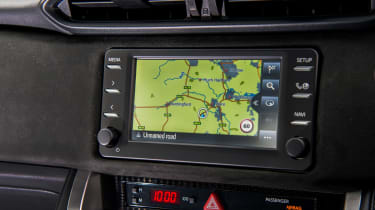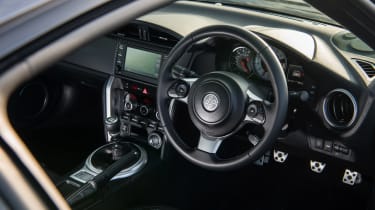Toyota GT86 (2012-2021) review - interior and tech
Little joy to be found in the design or materials, but the driving position is perfect. Rear seats aren't suitable for most humans.
The GT86 is definitely not going to win any awards for its interior, though things have improved for the 2017 facelift. Despite having immensely supportive, comfy and attractive seats and suede on the dash for that flocked-rally-car look, the inclusion of fake-carbon trim and hard plastics sets a distinctly low-rent tone.
But the focus here is on driving. The GT86 has a superb driving position (anyone over ten years old can forget sitting in the back, though) and the new steering wheel has been painstakingly designed to angle the driver’s arms inwards, which Toyota says ‘promotes a sportier feel’. And it does. The GT86 gets it right elsewhere, too, and though it can take a bit of adjustment, the pedal/seat/wheel/gearlever relationship can be perfectly arranged for a comfortable but engaging drive, and it often feels as though your backside is sat on the rear axle
The instrument cluster sets the right tone, too, with a clear central rev counter that puts the engine’s 7000rpm sweet spot dead centre (it has been reoriented for 2017). To its right is a 4.2-inch colour TFT screen that can display journey details, coolant temperatures, power and torque curves, lap time, a stopwatch and even G-force monitor (all very R34 Nissan GT-R).
The satnav has also been updated, and can be optioned with three years’ free map updates and access to live road-traffic information, Google and even Twitter. Unfortunately, it's far from being one of the better systems on the market, and entering an address seems to take an age. Luckily, the fact that Toyota is still using a double-DIN fitment for its system means there's a whole aftermarket of improvements out there; we'd opt for something with Apple CarPlay or Android Auto for a start.




